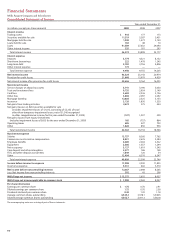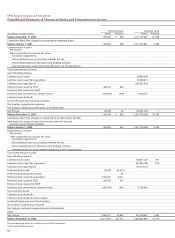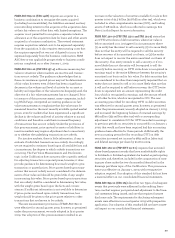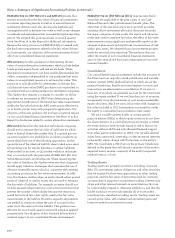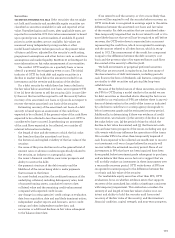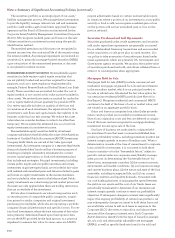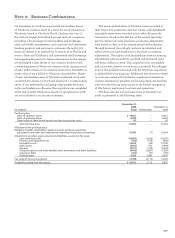Wells Fargo 2009 Annual Report Download - page 101
Download and view the complete annual report
Please find page 101 of the 2009 Wells Fargo annual report below. You can navigate through the pages in the report by either clicking on the pages listed below, or by using the keyword search tool below to find specific information within the annual report.
FASB ASC 805-10 (FAS 141R) requires an acquirer in a
business combination to recognize the assets acquired
(including loan receivables), the liabilities assumed, and any
noncontrolling interest in the acquiree at the acquisition date,
at their fair values as of that date, with limited exceptions. The
acquirer is not permitted to recognize a separate valuation
allowance as of the acquisition date for loans and other assets
acquired in a business combination. The revised statement
requires acquisition-related costs to be expensed separately
from the acquisition. It also requires restructuring costs that
the acquirer expected but was not obligated to incur, to be
expensed separately from the business combination. FASB
ASC 805-10 was applicable prospectively to business combi-
nations completed on or after January 1, 2009.
FASB ASC 820-10 (FSP FAS 157-4) addresses measuring fair
value in situations where markets are inactive and transac-
tions are not orderly. The guidance acknowledges that in
these circumstances quoted prices may not be determinative
of fair value; however, even if there has been a significant
decrease in the volume and level of activity for an asset or
liability and regardless of the valuation technique(s) used, the
objective of a fair value measurement has not changed. Prior
to issuance of this pronouncement, many companies, includ-
ing Wells Fargo, interpreted accounting guidance on fair
value measurements to emphasize that fair value must be
measured based on the most recently available quoted market
prices, even for markets that have experienced a significant
decline in the volume and level of activity relative to normal
conditions and therefore could have increased frequency
of transactions that are not orderly. Under the provisions of
this pronouncement, price quotes for assets or liabilities in
inactive markets may require adjustment due to uncertainty
as to whether the underlying transactions are orderly.
For inactive markets, there is little information, if any, to
evaluate if individual transactions are orderly. Accordingly,
we are required to estimate, based upon all available facts and
circumstances, the degree to which orderly transactions are
occurring. The Fair Value Measurements and Disclosures
topic in the Codification does not prescribe a specific method
for adjusting transaction or quoted prices; however, it does
provide guidance for determining how much weight to give
transaction or quoted prices. Price quotes based upon trans-
actions that are not orderly are not considered to be determi-
native of fair value and should be given little, if any, weight
in measuring fair value. Price quotes based upon transactions
that are orderly shall be considered in determining fair value,
with the weight given based upon the facts and circum-
stances. If sufficient information is not available to determine
if price quotes are based upon orderly transactions, less
weight should be given to the price quote relative to other
transactions that are known to be orderly.
The new measurement provisions of FASB ASC 820-10
were effective for second quarter 2009; however, as permitted
under the pronouncement, we early adopted in first quarter
2009. Our adoption of this pronouncement resulted in an
increase in the valuation of securities available for sale in first
quarter 2009 of $4.5 billion ($2.8 billion after tax), which was
included in other comprehensive income (OCI), and trading
assets of $18 million, which was reflected in earnings. See
Note 5 in this Report for more information.
FASB ASC 320-10 (FSP FAS 115-2 and FAS 124-2) states that
an OTTI write-down of debt securities, where fair value is
below amortized cost, is triggered in circumstances where
(1) an entity has the intent to sell a security, (2) it is more likely
than not that the entity will be required to sell the security
before recovery of its amortized cost basis, or (3) the entity
does not expect to recover the entire amortized cost basis of
the security. If an entity intends to sell a security or if it is
more likely than not the entity will be required to sell the
security before recovery, an OTTI write-down is recognized in
earnings equal to the entire difference between the security’s
amortized cost basis and its fair value. For debt securities that
are considered to be other-than-temporarily impaired that an
entity does not intend to sell or it is more likely than not that
it will not be required to sell before recovery, the OTTI write-
down is separated into an amount representing the credit
loss, which is recognized in earnings, and the amount related
to all other factors, which is recognized in OCI. The new
accounting prescribed for recording OTTI on debt securities
was effective for second quarter 2009; however, as permitted
under the pronouncement, we early adopted on January 1, 2009,
and increased the beginning balance of retained earnings by
$85 million ($53 million after tax) with a corresponding
adjustment to cumulative OCI for OTTI recorded in earnings
in previous periods on securities in our portfolio at January 1,
2009, that would not have been required had this accounting
guidance been effective for those periods. Additionally, the
new accounting prescribed for recording OTTI on debt
securities increased net income by $843 million (after tax)
and diluted earnings per share by $0.18 in 2009.
FASB ASC 260-10 (FSP EITF 03-6-1) requires that unvested
share-based payment awards that have nonforfeitable rights
to dividends or dividend equivalents be treated as participating
securities and, therefore, included in the computation of earn-
ings per share under the two-class method described in the
Earnings per Share topic of the Codification. This pronounce-
ment was effective on January 1, 2009, with retrospective
adoption required. Our adoption of this standard did not have
a material effect on our consolidated financial statements.
FASB ASC 855-10 (FAS 165) describes two types of subsequent
events that previously were addressed in the auditing litera-
ture, one that requires post-period end adjustment to the finan-
cial statements being issued, and one that requires footnote
disclosure only. The requirements for disclosing subsequent
events were effective in second quarter 2009 with prospective
application. Our adoption of this standard did not have a mate-
rial impact on our consolidated financial statements.



